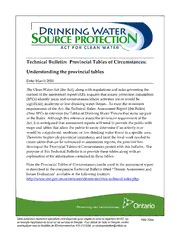
Technical bulletin : Provincial tables of circumstances - understand the provincial tables PDF
Preview Technical bulletin : Provincial tables of circumstances - understand the provincial tables
Technical Bulletin: Provincial Tables of Circumstances: Understanding the provincial tables Date: March 2010 The Clean Water Act (the Act), along with regulations and rules governing the content of the assessment report (AR), requires that source protection committees (SPCs) identify areas and circumstances where activities are or would be significant, moderate or low drinking water threats. To meet the minimum requirements of the Act, the Technical Rules: Assessment Report (the Rules) allow SPCs to reference the Tables of Drinking Water Threats that make up part of the Rules. Although this reference meets the minimum requirement of the Act, it is anticipated that assessment reports will need to provide the public with maps and tables that allow the public to easily determine if an activity is or would be a significant, moderate, or low drinking water threat in a specific area. Therefore, to provide provincial consistency and limit the local work needed to create tables that can be referenced in assessment reports, the province has developed the Provincial Tables of Circumstances posted with this bulletin. The purpose of this Technical Bulletin is to provide these tables along with an explanation of the information contained in these tables. How the Provincial Tables of Circumstances can be used in the assessment report is described in the companion Technical Bulletin titled “Threats Assessment and Issues Evaluation” available at the following location: http://www.ene.gov.on.ca/en/water/cleanwater/cwa‐technical‐rules.php. Cette publication hautement spécialisée n'est disponible qu'en anglais en vertu du règlement 441/97, qui PIBS 7584e en exemp te l'application de la Loi sur les services en français. Pour obtenir de l'aide en français, veuillez communiquer avec le ministère de l'Environnement au 416-212-5296, ou [email protected] Technical Bulletin: Addressing Transportation Threats Rationale for the Provincial Tables of Circumstances As part of the AR, SPCs are having vulnerability scoring maps developed for four types of vulnerable areas: Highly vulnerable aquifers (HVAs) – groundwater Significant Groundwater Recharge Areas (SGRAs) ‐ groundwater Wellhead Protection Areas (WHPAs) ‐ groundwater Intake Protection Zones (IPZs) – surface water Within these zones, vulnerability scores range from two to ten (2‐10). Theranges in scores for each type of area that can result in the identification of a threat are: HVAs – 6 SGRAs – 4, 6 WHPAs – 4, 6, 8, 10 IPZs ‐ 4.2, 4.5, 4.8, 4.9, 5, 5.4, 5.6, 6, 6.3, 6.4, 7, 7.2, 8, 8.1, 9, 10 Based on the possible combinations of areas and scores, 76 different Provincial Tables of Circumstances have been created to represent the different combinations for which there are provincially prescribed threats and circumstances within the Tables of Drinking Water Threats. Not all combinations of vulnerable area and score have threats and circumstances associated with them. The 76 tables are listed in the companion technical bulletin “Technical Bulletin: Threats Assessment and Issues Evaluation“. There are a number of components of each table that require an explanation. 1. The tables are broken up into 5 types of tables, chemical tables for groundwater, Dense Non‐Aqueous Phase Liquid (DNAPL) tables for groundwater, pathogen tables for groundwater, chemical and DNAPL tables for surface water, and pathogen tables for surface water. 2. Each of the 5 types of tables have been broken out into activities that are significant, moderate, or low drinking water threats for the vulnerability scores available for that type of vulnerable area. For example, chemical based activities in a WHPA with a score of 10, where the activity is a significant drinking water threat. 2 Technical Bulletin: Addressing Transportation Threats 3. Two names have been given to each table. The first is a provincial table number from 1 to 76. The second, in brackets after the provincial table number, is a table name that used the following identifiers: C – Chemical P – Pathogen D – DNAPL W – WHPA IPZ – IPZ IPZWE – IPZ and WHPA‐E (number) ‐ vulnerability score S – Significant Drinking Water Threats M – Moderate Drinking Water Threats L ‐ Drinking Water Threats A – All vulnerability scores 4. For the chemical and DNAPL tables, an explanation of the table set up is provided on page 4. 5. For pathogens, an explanation of the table set up is provided on page 5. 3 Technical Bulletin: Provincial Tables of Circumstances Circumstance from the November 2009 Tables of Drinking Water Reference Number from the Threats Threat Subcategory (from database), which November 2009 Tables of provides a way to group circumstances under Drinking Water Threats the prescribed threat. This is only provided Blank field means that the circumstance is the same as the last one listed. where the subcategory and prescribed threat This generally means that there are a group of chemicals that apply to the wording is sufficiently different. same circumstance. This can help the reader see where an activity can have multiple chemicals of concern associated with it, which in most cases means Prescribed Threat Chemical of concern: in many cases it could be counted as one activity when enumerating significant threats. there are a number of chemicals associated with the same activity and circumstances. 4 Technical Bulletin: Provincial Tables of Circumstances Reference number from November 2009 Tables of Drinking Water Threats Threat Subcategory (from database), which provides a way to group circumstances Circumstance: the circumstances from under the prescribed threat. Prescribed Threat the tables of drinking water threats. 5
